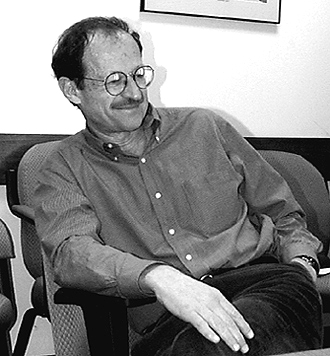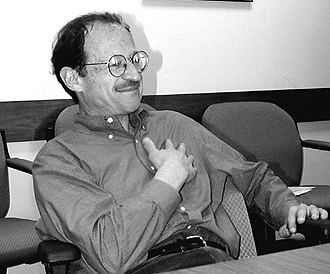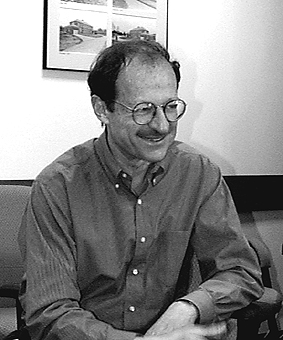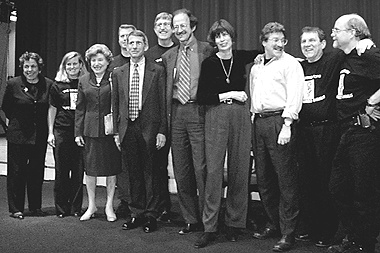T H E N I H C A T A L Y S T J A N U A R Y – F E B R U A R Y 2 0 0 0
HAROLD
VARMUS: LIKE A ROLLING
STONE (WITH
RECEPTORS)
by Fran Pollner
 |
|
Harold Varmus: "I’m going from one very good job to another very good job." |
 |
|
"When
recombinant DNA came to the table 25 years ago, society was shocked;
no one had thought much about ethical issues in biology. In general,
we've become much better at this."
|
 |
|
"I
plan to make a tape (of some of the 'goodbye party'; see below)
to show at Memorial Sloan-Kettering, so people can see how we have
fun here and how I plan to interact . . . "
|
In the last month of the twentieth century, Harold Varmus took his leave of NIH. He offered "valedictory thoughts" to his scientific advisory committee at his final meeting with them; he bid fond adieu to the NIH community gathered in Masur Auditorium to laugh away the pangs of parting (see "Coda," below); and he obliged reporters from The NIH Catalyst, the NIH Record, Nature, Science & Government Reports, Washington Fax, and the Blue Sheet with a farewell interview.
Time To Go
Why are you leaving? asked a reporter. "It began to feel repetitive," Varmus said, especially the annual appropriations process. And, he added, there was also the matter of "timing": "To have gone deeply into my sixties would have reduced the chances of getting another really good job—and this particular job became available now," he said of the opportunity to head the Memorial Sloan-Kettering Cancer Center (MSKCC) in New York City. "In an ideal world, I probably would have left [NIH] one year after the next administration came in"–in which case he would have gone through two more of those appropriations shuffles he does not relish but which he counts among the priorities for the NIH leadership.
It’s up to NIH leaders to chart and promote the "right flight path" for future budgets, he said. It’s also up to them to recognize that technologic advances and the "genomic revolution" could drive "deeper divisions in access," in which case, he told his advisory group, "we won’t have achieved the NIH mission of improving the public health and we will look like an institution that serves the elite." Similarly, he told reporters of his concern that "we’re going to cut a significant proportion of the population out of the benefits of certain approaches to health that are paid for with public money and that ought to be publicly accessible." Current NIH initiatives related to research into health disparities should help, as should tapping the wisdom of the NIH director’s Council of Public Representatives (COPR), an activity his successor would be well-advised to engage in seriously and often, he said.
"I was slow to appreciate the importance of a nonsectarian council like COPR, a good sounding board," he said, for scientific, political, and ethical matters, especially equity and health disparity issues.
Infrastructure
Varmus repeated his suggestion that NIH be reconfigured into perhaps five "clusters" that would logically organize existing centers and institutes and discourage add-ons, but such a proposal from him or any NIH official, he said, would appear self-serving. Rather, he hopes Congress or the National Academy of Sciences will some day arrive at a similar conclusion based on independent study, and then such a reorganization could be accepted and implemented. His own dim view of proliferating NIH institutes is well known, he noted. Far better, from both scientific and administrative viewpoints, are NIH’s new interdisciplinary Neuroscience Center and the new transinstitute Office of Bioimaging and Bioengineering (asked for and received in the appropriations bill).
But there are still some components of the intramural research program that "are too far removed from the centers of activity. These [geographically] outlying groups are a worry," he said.
Nearly out the NIH door, Varmus nonetheless used the word "we" frequently in addressing future courses of action for NIH. It was also clear, however, that his future at the biomedical complex on New York’s East Side was close upon him and he was eager for it.
The Varmus Lab
"I will be at a place," he said, "where cancer research and cancer treatment coexist–at a strong institution, with interesting neighbors (New York University–Cornell Medical Center, Rockefeller University) and many good friends and colleagues." And, of course, he’ll be taking his lab with him—a lab, he proudly said as the interview opened, that had "just received a quite favorable review" from NCI. He noted with bemusement that someone had asked, "Who’s going to run the Varmus lab now?" as if it were a permanent entity at NIH and not the work-in-progress of the person who brought it to NIH and would be taking it with him when he left.
Indeed, at the MSKCC, Varmus will have more time to spend in that lab than he did at NIH, where, he said, he really couldn’t "settle in" in the hour or so a day and off-hours that he had there. Half his time in New York, he said, will be in his hospital executive office and the other half will be in his lab. The administrative aspects of the new job may actually be more onerous than his counterpart tasks as NIH director, which dealt less with administrative details than with the broader policy issues he enjoys grappling with. Nonetheless, it’s the science that’s most compelling, and the science in the Varmus lab, he said, has been centered on "two major themes":
![]() Getting better models for studying human cancer in the mouse. No longer
confined to making transgenics and crossing them with knockouts, the Varmus
team has been using viral vectors to deliver conditional genes to organs
expressing target receptors. The repertoire has included oncogenes, tumor-suppressor
genes, marker genes, and recombinases, or genes programmed to be rearranged.
They’ve been working with tumors characteristically hard to grow
in cell culture, such as gliomas and breast tumors, and are crafting models
for lung, pancreatic, and ovarian cancer. Ultimately, knowledge of gene
abnormalities in human cancer should yield therapeutic and preventive
interventions that are less toxic and more effective than currently available
agents. It should also yield a more profound understanding of metastasis.
Getting better models for studying human cancer in the mouse. No longer
confined to making transgenics and crossing them with knockouts, the Varmus
team has been using viral vectors to deliver conditional genes to organs
expressing target receptors. The repertoire has included oncogenes, tumor-suppressor
genes, marker genes, and recombinases, or genes programmed to be rearranged.
They’ve been working with tumors characteristically hard to grow
in cell culture, such as gliomas and breast tumors, and are crafting models
for lung, pancreatic, and ovarian cancer. Ultimately, knowledge of gene
abnormalities in human cancer should yield therapeutic and preventive
interventions that are less toxic and more effective than currently available
agents. It should also yield a more profound understanding of metastasis.
![]() Understanding
how growth and differentiation factors (such as WNT proteins, fibroblast
growth factors, and hedgehog and TGF-b genes) signal the cell nucleus
to alter the way the cell behaves. Varmus’s interest in signaling
was "activated" about 20 years ago, he said, when he and his
colleagues discovered the first WNT gene and traced the role of
WNT1 in cancer development after the insertion of viral DNA from
the mouse mammary tumor virus.
Understanding
how growth and differentiation factors (such as WNT proteins, fibroblast
growth factors, and hedgehog and TGF-b genes) signal the cell nucleus
to alter the way the cell behaves. Varmus’s interest in signaling
was "activated" about 20 years ago, he said, when he and his
colleagues discovered the first WNT gene and traced the role of
WNT1 in cancer development after the insertion of viral DNA from
the mouse mammary tumor virus.
The World at Large
Asked if he would miss his role in the international arena, working on such problems as malaria, he replied: "I’d miss it if I lost it, but I don’t think I will." He’ll likely be a consultant to the World Health Organization and will soon be traveling to India; he’ll also continue his involvement in PubMed Central, which, he said, is an "important issue in international health and the support of science in the developing world."
Beyond that, he’ll be rejoining the steering committee of the American Society for Cell Biology, from which, he said, he was apparently granted a "six-year leave of absence." And he’s been asked to join the "p53 Club" in New York, as well as many other clubs, athletic and scientific, that he will consider once he figures out how much time his job leaves him for other pursuits. Among other things he looks forward to are New York’s artistic offerings, having to answer to "fewer bosses," and "more flexible interactions with the private sector," although he intends to "serve only on nonprofits."
Recollections
But he will leave behind the NIH intramural program, which "from the first day I arrived here, I’ve really enjoyed"— his scientific collaborations, the seminars, the interest groups, the "esprit," and the campus building boom. He lauded the speed with which NIH was able to respond to a perceived national need—both physically and intellectually—with the building of the Vaccine Research Center and recruitment of Gary Nabel as its director.
For none of these aspects of NIH for which he expressed appreciation did Varmus take credit. He even punctuated his praise of the Clinical Center’s activity level and clinical research on campus in general with an aside that though he himself did not contribute to the clinical side of NIH studies, his research had benefited from its resources, such as the small animal imaging facility.
But he had some good things to say for his handling of several matters as NIH director.
On patents: "I chose not to pursue intellectual property rights on anonymous cDNAs, and I think that was the right decision. Why prosecute a claim you don’t think should be made? I’m pleased the Patent Trademark Office is closer to our position now: that the specific utility must be known in order to patent a squence."
On material transfer agreements: "We’re not trying to lay down a strict law but to move the scientific community to a more generous mode of behavior. We had a major success with Cre-Lox technology, and although our hold is less secure with corporate entities that don’t have NIH funding, the movement is in the direction of greater sharing."
On PubMed Central: "Once it’s unveiled, the public interest will soar."
On stem cell research: "This issue will continue to heat up. I look back with a sense of pride at the Human Embryo Research Report of 1994, which was prescient [regarding issues raised in 1999]."
On his past actions to recast the role of the NIH Recombinant DNA Advisory Committee (RAC): "I have no objection to its being put on the table [that RAC again approve gene therapy protocols], but I think it’s the wrong way to go. Jesse Gelsinger’s death would not have been prevented if the RAC had approval authority, and NIH is not a regulatory agency [see Catalyst coverage of the RAC meeting in December on these matters, Gene Therapy Trial and Errors, this issue]. I don’t think we should respond to this unfortunate episode by returning RAC to what was a somewhat dysfunctional state. Now it’s working well."
Asked if he had
any disappointments, he said he rued his lack of visible success in increasing
the numbers of investigators from minority backgrounds. "I haven’t
seen major changes. . . . Perhaps you couldn’t in just six years."
![]()
